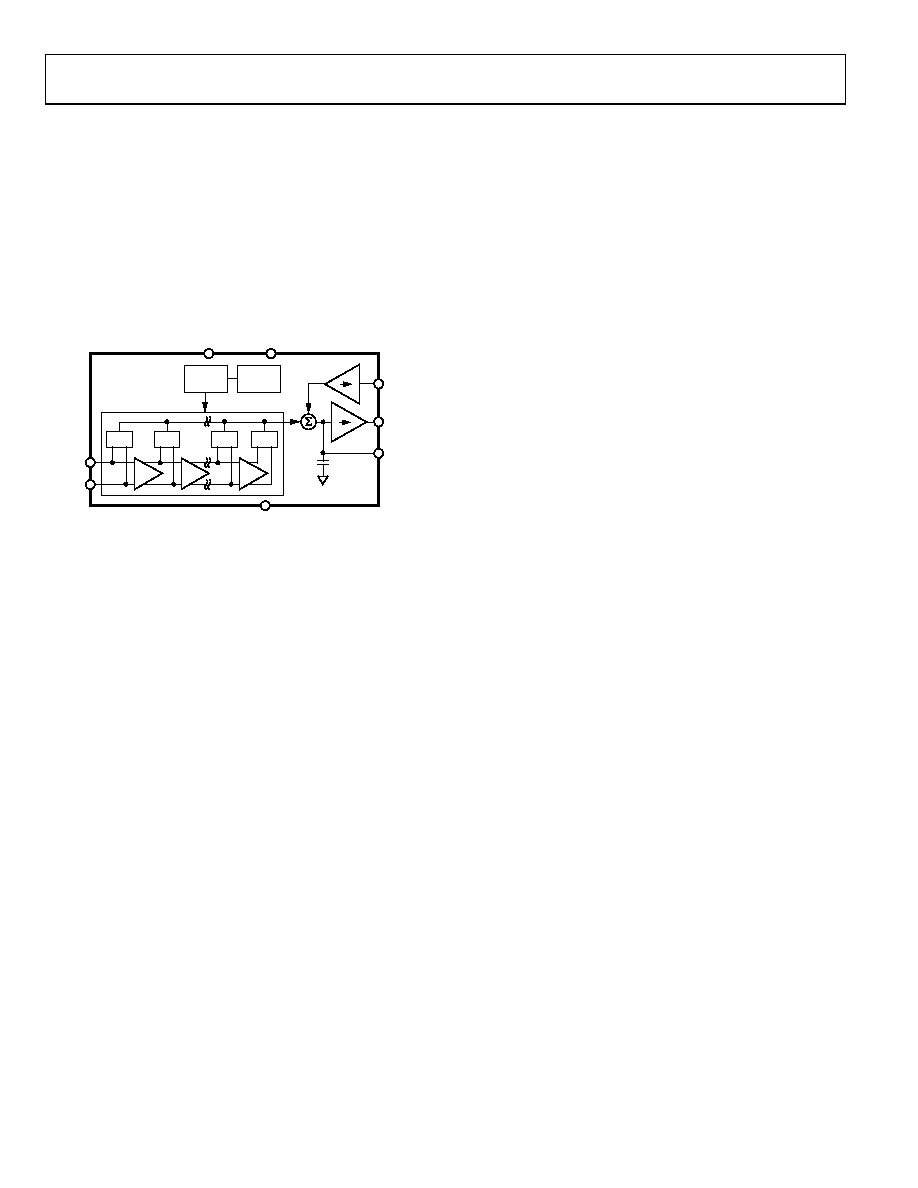- 您現(xiàn)在的位置:買賣IC網(wǎng) > PDF目錄2062 > AD8317ACPZ-R7 (Analog Devices Inc)IC AMP LOG DETECT 8GHZ 8-LFCSP PDF資料下載
參數(shù)資料
| 型號: | AD8317ACPZ-R7 |
| 廠商: | Analog Devices Inc |
| 文件頁數(shù): | 2/20頁 |
| 文件大小: | 0K |
| 描述: | IC AMP LOG DETECT 8GHZ 8-LFCSP |
| 產(chǎn)品培訓模塊: | Choosing and Using RF Detectors |
| 標準包裝: | 1 |
| 類型: | 對數(shù)放大器 |
| 應(yīng)用: | 接收器信號強度指示(RSSI) |
| 安裝類型: | 表面貼裝 |
| 封裝/外殼: | 8-VFDFN 裸露焊盤 |
| 供應(yīng)商設(shè)備封裝: | 8-LFCSP-VD(3x2) |
| 包裝: | 標準包裝 |
| 產(chǎn)品目錄頁面: | 550 (CN2011-ZH PDF) |
| 其它名稱: | AD8317ACPZ-R7DKR |

AD8317
Rev. B | Page 10 of 20
THEORY OF OPERATION
The AD8317 is a 6-stage demodulating logarithmic amplifier,
specifically designed for use in RF measurement and power
control applications at frequencies up to 10 GHz. A block
diagram is shown in Figure 21. Sharing much of its design
with the AD8318 logarithmic detector/controller, the AD8317
maintains tight intercept variability vs. temperature over a 50 dB
range. Additional enhancements over the AD8318, such as a
reduced RF burst response time of 6 ns to 10 ns, 22 mA supply
current, and board space requirements of only 2 mm × 3 mm,
add to the low cost and high performance benefits of the AD8317.
GAIN
BIAS
SLOPE
DET
INHI
INLO
IV
VOUT
VSET
CLPF
TADJ
VPOS
COMM
05
54
1-
02
1
IV
Figure 21. Block Diagram
A fully differential design, using a proprietary, high speed SiGe
process, extends high frequency performance. Input INHI receives
the signal with a low frequency impedance of nominally 500 Ω
in parallel with 0.7 pF. The maximum input with ±1 dB log-
conformance error is typically 0 dBm (re: 50 Ω). The noise
spectral density referred to the input is 1.15 nV/√Hz, which is
equivalent to a voltage of 118 μV rms in a 10.5 GHz bandwidth
or a noise power of 66 dBm (re: 50 Ω). This noise spectral
density sets the lower limit of the dynamic range. However,
the low end accuracy of the AD8317 is enhanced by specially
shaping the demodulating transfer characteristic to partially
compensate for errors due to internal noise. The common pin,
COMM, provides a quality low impedance connection to the
printed circuit board (PCB) ground. The package paddle, which
is internally connected to the COMM pin, should also be grounded
to the PCB to reduce thermal impedance from the die to the PCB.
The logarithmic function is approximated in a piecewise fashion
by six cascaded gain stages. (For a more comprehensive expla-
nation of the logarithm approximation, see the AD8307 data
sheet.) The cells have a nominal voltage gain of 9 dB each and a
3 dB bandwidth of 10.5 GHz. Using precision biasing, the gain
is stabilized over temperature and supply variations. The overall
dc gain is high, due to the cascaded nature of the gain stages. An
offset compensation loop is included to correct for offsets
within the cascaded cells. At the output of each of the gain
stages, a square-law detector cell is used to rectify the signal.
The RF signal voltages are converted to a fluctuating differential
current having an average value that increases with signal level.
Along with the six gain stages and detector cells, an additional
detector is included at the input of the AD8317, providing a
50 dB dynamic range in total. After the detector currents are
summed and filtered, the following function is formed at the
summing node:
ID × log10(VIN/VINTERCEPT)
(1)
where:
ID is the internally set detector current.
VIN is the input signal voltage.
VINTERCEPT is the intercept voltage (that is, when VIN = VINTERCEPT,
the output voltage would be 0 V, if it were capable of going to 0 V).
相關(guān)PDF資料 |
PDF描述 |
|---|---|
| AD8321ARZ | IC LINE DRIVER CATV 3.3V 20SOIC |
| AD8322ARUZ-REEL | IC LN DVR CATV COARS-STP 28TSSOP |
| AD8324JRQZ-REEL | IC LINE DRIVER CBL 3.3V 20QSOP |
| AD8325ARUZ-REEL | IC LN DVR CATV FINE-STEP 28TSSOP |
| AD8326AREZ | IC LINE DVR CATV PROG 28TSSOP |
相關(guān)代理商/技術(shù)參數(shù) |
參數(shù)描述 |
|---|---|
| AD8317ACPZ-R7 | 制造商:Analog Devices 功能描述:IC LOGARITHMIC AMPLIFIER 20NS LFCSP-8 |
| AD8317ACPZ-WP | 制造商:Analog Devices 功能描述: |
| AD8317-EVAL | 制造商:AD 制造商全稱:Analog Devices 功能描述:1 MHz to 10 GHz, 50 dB Log Detector/Controller |
| AD8317-EVALZ | 制造商:Analog Devices 功能描述:EVAL KIT FOR 1 MHZ TO 10 GHZ, 50 DB LOG DETECTOR/CNTRLR - Bulk 制造商:Analog Devices 功能描述:EVAL BOARD, AD8317 LOG DETECTOR/CNTRL, Silicon Manufacturer:Analog Devices, Silicon Core Number:AD8317, Kit Application Type:RF / IF, Kit Contents:Eval Board AD8317, Features:(Not Applicable) |
| AD8318 | 制造商:AD 制造商全稱:Analog Devices 功能描述:1 MHz to 8 GHz, 70 dB Logarithmic Detector/Controller |
發(fā)布緊急采購,3分鐘左右您將得到回復。